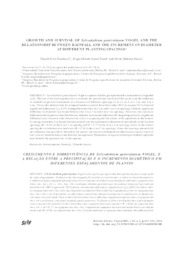Growth and survival of Sclerolobium paniculatum vogel and the relationship between rainfall and the increment in diameter at different planting spacings.
Growth and survival of Sclerolobium paniculatum vogel and the relationship between rainfall and the increment in diameter at different planting spacings.
Author(s): NARDUCCI, T. S.; YARED, J. A. G.; BRIENZA JUNIOR, S.
Summary: Sclerolobium paniculatum Vogel is a species that has good potential for reclamation of degraded soils. The aim of the investigation was to evaluate the growth and survival of the species and the influence of rainfall on growth in diameter as a function of different spacings (4 m x 2 m, 4 m x 3 m, and 4 m x 4 m). The results indicate that the temporal analysis (period from November 2007 to August 2013) detected significant differences (p ? 0.05) in height between the 4 m x 2 m and 4 m x 4 m spacings, while no significant difference in diameter was found between the 4 m x 2 m and 4 m x 3 m spacings. However, the statistical differences did not persist when the data was analyzed at seven and half years old. Regarding survival, a significant difference was observed only between the 4 m x 4 m spacing and the others, with superiority to the former. A strong correlation was found between rainfall and the increment in diameter of individuals in the broader spacings (R = 0.80 in the 4 m x 3 m spacing and R = 0.77 in the 4 m x 4 m spacing), while in the denser spacing the correlation was moderate (R = 0.56 in the 4 m x 2 m spacing). Since the spacings adopted did not influence tree growth by the end of the period, the choice will depend on other factors such as survival and costs of implementation and forestry management. Plantations in regions with larger rainfall amplitude may benefit the productivity of the species.
Publication year: 2016
Types of publication: Journal article
Unit: Embrapa Amapá
Observation
Some of Embrapa's publications are published as ePub files. To read them, use or download one of the following free software options to your computer or mobile device. Android: Google Play Books; IOS: iBooks; Windows and Linux: Calibre.
Access other publications
Access the Agricultural Research Database (BDPA) to consult Embrapa's full library collection and records.
Visit Embrapa Bookstore to purchase books and other publications sold by Embrapa.

